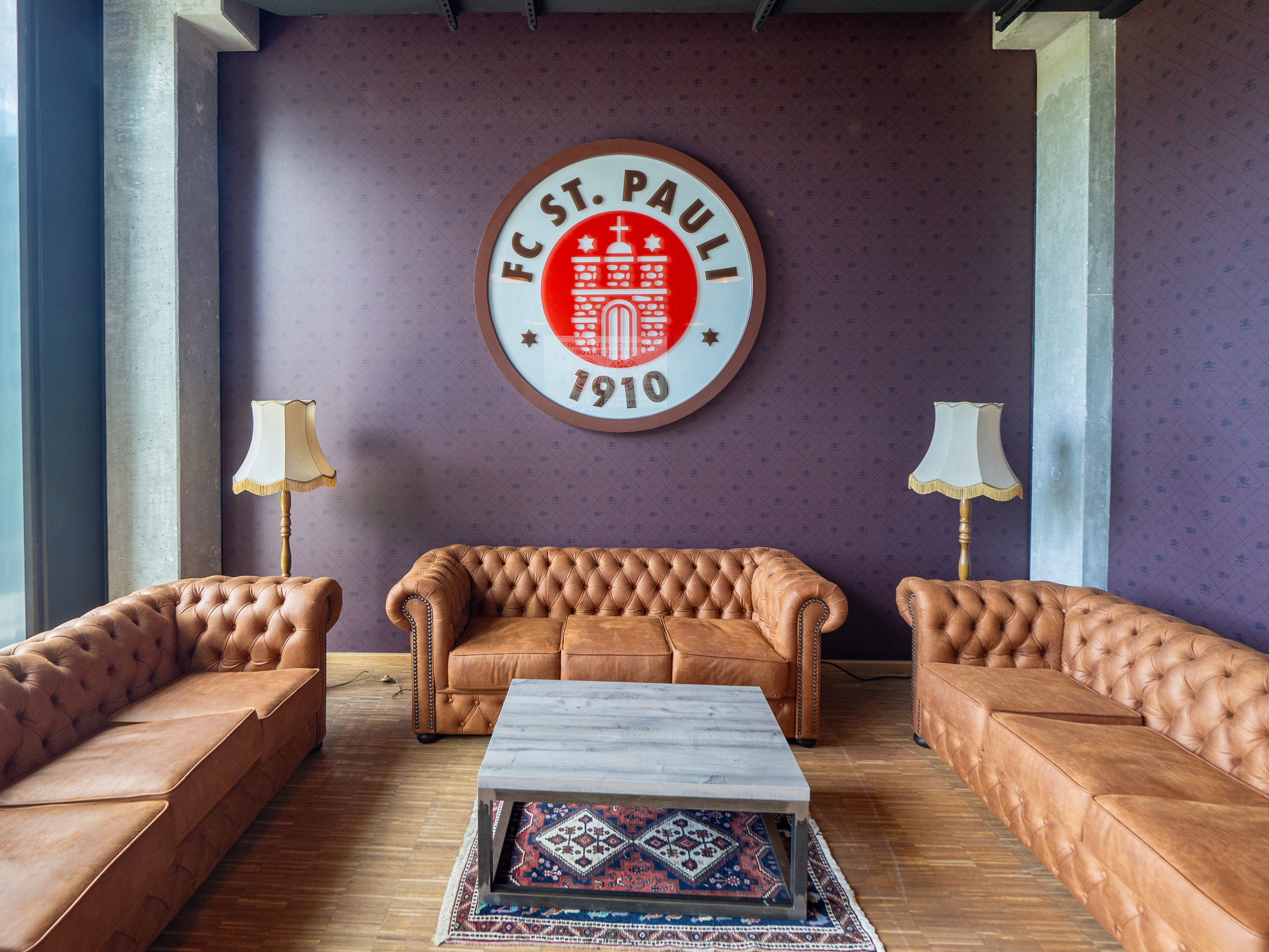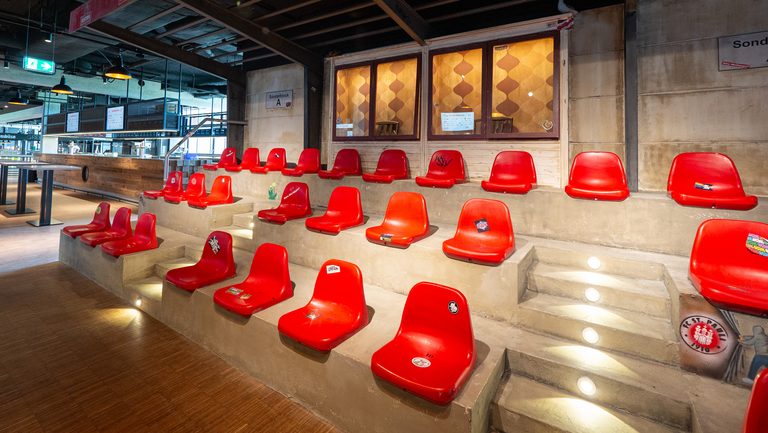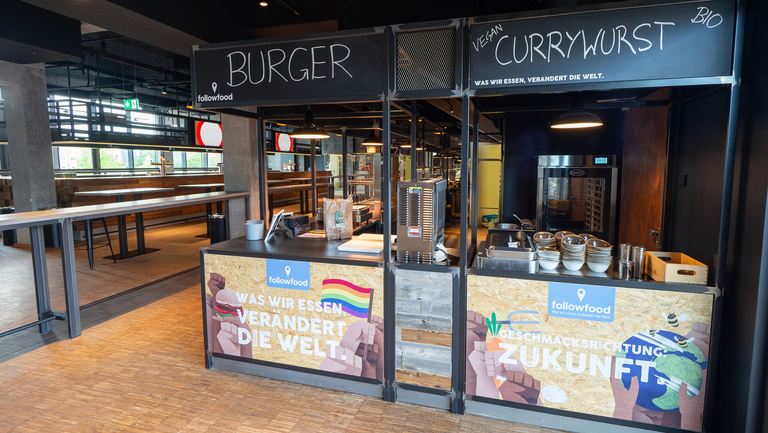Hamburg, Germany, August 7, 2023. Anyone who has renovated an old building knows that making it fit for the future, while at the same time preserving its generally rough charm and adhering to the budget and the deadline, is rather like a soccer player who scores three goals in the same half – like a hat trick of renovation.The real specialist here is the St. Pauli soccer club, which has often faced this sort of construction challenge over the last few decades.After all, much is at stake here.There is hardly any other soccer stadium which fascinates both fans and sympathizers from all over the world as much as the Millerntor, which is situated at the heart of the Hamburg district of St. Pauli. The club used the summer break to achieve an ambitious intermediate target for the season. Until recently, the south stand was a hive of building activity to ensure that the newly designed ballroom could be dedicated in time for the first home game at the weekend. Drees & Sommer SE smoothly and successfully managed the project, despite a tight timeframe. The role of the company, which specializes in construction and real estate consulting, was somewhat like that of a kit manager.
The home stadium of FC St. Pauli, which is lovingly referred to as its living room, is unique – not only because of its unrivaled location. The Millerntor stadium is set in the middle of the local district and close to landmarks such as Heiligengeistfeld and Reeperbahn, so it reflects the local district more than any other stadium, and it also reflects the clear values of the club and its fans. The traditional brown and white club colors, the legendary skull and the banner and flags stand for colorful diversity, tolerance and openness. Nowhere else do the fans have such an intense relationship with the local club’s stadium. When any changes are made – in the structure or the underlying concept – a great deal of tact is always needed.
A Focus on Service instead of Crowded VIP Areas
The Millerntor stadium has two business areas, i.e. the ballrooms in the south stand and the main stand. Guests in the business seat areas can go there before and during the game and at half time to obtain food and drinks. But both areas are now showing their age. “Renovation work in the ballroom south began during the summer break. Our aim was not just to enhance the VIP area visually, we also wanted to improve the quality of the time spent there and the overall game experience for our guests. Therefore we developed a new hospitality concept. To ensure that the ballroom is not so crowded during home games, we reduced the number of business tickets from 1,000 to 650. We had to increase the prices to cover the higher costs, but we did not want to do this without a major improvement in the product,” explains Martin Geisthardt, Head of Commercial and Marketing of the FC St. Pauli. The reduction in VIP seats actually benefits the public area, where there are now more seat tickets. The 39 spectator boxes remain unchanged, at FC St. Pauli they are referred to as ‘séparées’.
With significantly more space and less crowding, Martin Geisthardt comments that better service and more sustainable catering at a high-quality level are now possible: “We can place a greater focus on local producers and making everything more regional and seasonal. We are also significantly extending the range of vegan and vegetarian food. As a new venture, we also want to ask systematically what foods are particularly popular to ensure that there is less leftover food after the game.” The new sustainable range of food includes not only vegan sausages, but also a new organic premium sausage, which sells about 10,000 sausages on match days at Millerntor.
Design Based on the St. Pauli Style: Modern, Rough, Authentic, but with a Posh ‘Schiggi Miggi’ Touch
The new elements in the VIP area also include a stage and the fan pub known as ‘Schiggi Miggi’, which is also open on days when there is no match. In addition, business ticket holders can come here to watch St. Pauli's away games. “The new ballroom south is based on a design concept by the agency Nordpol+ and is characterized by the club colors and the use of wood and metal. The technical installations under the ceilings are deliberately left exposed,” says interior architect Jan-Ole Bülow. Drees & Sommer’s Senior Head of Planning was responsible for the implementation of the innovative Nordpol concept.
The modern and slightly rough style, which is a hallmark of the St. Pauli soccer club, is also underlined by the newly created stage for interviews and live acts. It is framed by old metal barriers, the original crush barriers from the stadium, complete with paint, writing and stickers. Another highlight is the central bar which has been modified so that it can be accessed from three sides. It is supplemented by two additional counters and seven catering stations. On match days there is still a separate area for the players. On days when there is no match, this splendid room can especially be used as a meeting room to relieve the pressure on the offices of FC St. Pauli. All current changes in the club are designed to make the ballroom more attractive for outside customers who can plan external events apart from the matches. This also aims to help recoup the financial outlay for the building work.
The Right Lineup and Tactics Are Also Important for the Renovation Activities
The short time window of the summer break was the only time that could be used for the whole of the alteration work. “All work on the site had to be carried out within just under two months, and the time frame for the whole project, including the planning, the tender process, the award of contracts and the building work, was a total of only seven months. From the outset, there was immense pressure to maintain the intensive project management and to ensure a strict schedule for all trades,“ says Tristan Schmedes of Drees & Sommer, who managed the alteration work as Overall Project Leader. To avoid delays, reworking, unnecessary waiting periods and waste of personnel time and materials, the Drees & Sommer team used the lean construction management method. Tristan Schmedes describes the concept as follows: “The central requirement is a detailed project sequence plan which is finely tuned with exact dates. This means that it is clear at all times how many workers, what materials and what machines are needed, and exactly when they are needed.” The Hamburg-based team of experts from Drees & Sommer was responsible for general construction management in the alteration process and supported the club with the general planning of the architecture and the technical building installations, a new lighting concept and the project and construction management.
After the Alteration Work is Before the Alteration Work
Next year, the alteration work in the second business area in the main stand is due to begin – assuming that the grassroots fans of the soccer club are happy with the changes in the south stand. “We regard the first year as a trial run to find out whether our changes can also be implemented in the main stand, and what aspects may need to be adjusted and improved,” commented Martin Geisthardt with regard to possible next steps. The time window for the alteration work would be similarly tight – but the ballroom in the main stand is more than twice the area of the ballroom in the south stand.


